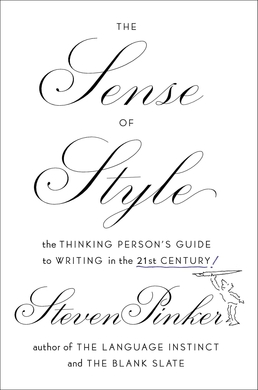Related Research Articles

The Elements of Style is a style guide to writing American English, published in numerous editions. The original was written by William Strunk Jr. in 1918, and published by Harcourt in 1920, comprising eight "elementary rules of usage," ten "elementary principles of composition," "a few matters of form," a list of 49 "words and expressions commonly misused," and a list of 57 "words often misspelled." Writer and editor E. B. White greatly enlarged and revised the book for publication by Macmillan in 1959. That was the first edition of the so-called Strunk & White, which Time recognized in 2011 as one of the 100 best and most influential books written in English since 1923.

A Dictionary of Modern English Usage (1926), by Henry Watson Fowler (1858–1933), is a style guide to British English usage, pronunciation, and writing. Covering topics such as plurals and literary technique, distinctions among like words, and the use of foreign terms, the dictionary became the standard for other style guides to writing in English. Hence, the 1926 first edition remains in print, along with the 1965 second edition, edited by Ernest Gowers, which was reprinted in 1983 and 1987. The 1996 third edition was re-titled as The New Fowler's Modern English Usage, and revised in 2004, was mostly rewritten by Robert W. Burchfield, as a usage dictionary that incorporated corpus linguistics data; and the 2015 fourth edition, revised and re-titled Fowler's Dictionary of Modern English Usage, was edited by Jeremy Butterfield, as a usage dictionary. Informally, readers refer to the style guide and dictionary as Fowler's Modern English Usage, Fowler, and Fowler's.
News style, journalistic style, or news-writing style is the prose style used for news reporting in media, such as newspapers, radio and television.
Plain language is writing designed to ensure the reader understands as quickly, easily, and completely as possible. Plain language strives to be easy to read, understand, and use. It avoids verbose, convoluted language and jargon. In many countries, laws mandate that public agencies use plain language to increase access to programs and services. The United Nations Convention on the Rights of Persons with Disabilities includes plain language in its definition of communication.
Pleonasm is redundancy in linguistic expression, such as "black darkness," "burning fire," "the man he said," or "vibrating with motion." It is a manifestation of tautology by traditional rhetorical criteria and might be considered a fault of style. Pleonasm may also be used for emphasis, or because the phrase has become established in a certain form. Tautology and pleonasm are not consistently differentiated in literature.
In English-language punctuation, the serial comma, also referred to as the series comma, Oxford comma, or Harvard comma, is a comma placed immediately after the penultimate term and before the coordinating conjunction in a series of three or more terms. For instance, a list of three countries might be punctuated without the serial comma as "France, Italy and Spain" or with the serial comma as "France, Italy, and Spain". The serial comma can serve to avoid ambiguity in specific contexts, though its employment may also generate ambiguity under certain circumstances.

RAS syndrome is the redundant use of one or more of the words that make up an acronym in conjunction with the abbreviated form. This means, in effect, repeating one or more words from the acronym. Three common examples are "PIN number"/"VIN number" and "ATM machine". The term RAS syndrome was coined in 2001 in a light-hearted column in New Scientist.
Subtext is any content of a creative work which is not announced explicitly but is implicit, or becomes something understood by the audience. Subtext has been used historically to imply controversial subjects without drawing the attention of censors. This has been especially true in comedy; it is also common in science fiction, where it can be easier—and/or safer—to deliver a social critique if, e.g., set in a time other than the (author's) present.
In literary criticism, purple prose is overly ornate prose text that may disrupt a narrative flow by drawing undesirable attention to its own extravagant style of writing, thereby diminishing the appreciation of the prose overall. Purple prose is characterized by the excessive use of adjectives, adverbs, and metaphors. When it is limited to certain passages, they may be termed purple patches or purple passages, standing out from the rest of the work.
In linguistics, a redundancy is information that is expressed more than once.

In English, the passive voice is marked by a subject that is followed by a stative verb complemented by a past participle. For example:
The enemy was defeated. Caesar was stabbed.

Legal writing involves the analysis of fact patterns and presentation of arguments in documents such as legal memoranda and briefs. One form of legal writing involves drafting a balanced analysis of a legal problem or issue. Another form of legal writing is persuasive, and advocates in favor of a legal position. Another form legal writing involves drafting legal instruments, such as contracts and wills.

The rhetorical modes are a broad traditional classification of the major kinds of formal and academic writing by their rhetorical (persuasive) purpose: narration, description, exposition, and argumentation. First attempted by Samuel P. Newman in A Practical System of Rhetoric in 1827, the modes of discourse have long influenced US writing instruction and particularly the design of mass-market writing assessments, despite critiques of the explanatory power of these classifications for non-school writing.
In literature, writing style is the manner of expressing thought in language characteristic of an individual, period, school, or nation. As Bryan Ray notes, however, style is a broader concern, one that can describe "readers' relationships with, texts, the grammatical choices writers make, the importance of adhering to norms in certain contexts and deviating from them in others, the expression of social identity, and the emotional effects of particular devices on audiences." Thus, style is a term that may refer, at one and the same time, to singular aspects of an individual's writing habits or a particular document and to aspects that go well-beyond the individual writer. Beyond the essential elements of spelling, grammar, and punctuation, writing style is the choice of words, sentence structure, and paragraph structure, used to convey the meaning effectively. The former are referred to as rules, elements, essentials, mechanics, or handbook; the latter are referred to as style, or rhetoric. The rules are about what a writer does; style is about how the writer does it. While following the rules drawn from established English usage, a writer has great flexibility in how to express a concept. Some have suggested that the point of writing style is to:
Persuasive writing is a form of writing intended to convince or influence readers to accept a particular idea or opinion and to inspire action. A wide variety of writings, such as criticisms, reviews, reaction papers, editorials, proposals, advertisements, and brochures, utilize different persuasion techniques to influence readers. Persuasive writing can also be employed in indoctrination. It is often confused with opinion writing; however, while both may share similar themes, persuasive writing is backed by facts, whereas opinion writing is supported by emotions.
Joseph M. Williams was a professor in the Department of English Language and Literature at the University of Chicago where he promoted clarity in writing for many years. He authored several books on language and writing.
Verbosity, or verboseness, is speech or writing that uses more words than necessary. The opposite of verbosity is succinctness.
In rhetoric, parallel syntax is a rhetorical device that consists of repetition among adjacent sentences or clauses. The repeated sentences or clauses provide emphasis to a central theme or idea the author is trying to convey. Parallelism is the mark of a mature language speaker.

The Sense of Style: The Thinking Person's Guide to Writing in the 21st Century is a 2014 English style guide written by cognitive scientist, linguist and popular science author Steven Pinker. Building upon earlier guides, such as Strunk & White's The Elements of Style and Fowler's A Dictionary of Modern English Usage, it applies science to the process of writing, and explains its prescriptions by citing studies in related fields – e.g., grammatical phenomena, mental dynamics, and memory load – as well as history and criticism, to "distinguish the rules that enhance clarity, grace, and emotional resonance from those that are based on myths and misunderstandings".
An expletive is a word or phrase inserted into a sentence that is not needed to express the basic meaning of the sentence. It is regarded as semantically null or a placeholder. Expletives are not insignificant or meaningless in all senses; they may be used to give emphasis or tone, to contribute to the meter in verse, or to indicate tense.
References
- ↑ Garner, Bryan A. (2009). Garner on Language and Writing: Selected Essays and Speeches of Bryan A. Garner. Chicago: American Bar Association. p. 295. ISBN 978-1-60442-445-4.
- 1 2 William Strunk (1918). The Elements of Style.
- ↑ UNT Writing Lab. "Concision, Clarity, and Cohesion." Accessed June 19, 2012. Link.
- ↑ Program for Writing and Rhetoric, University of Colorado at Boulder. "Writing Tip #27: Revising for Concision and Clarity." Accessed June 19, 2012. Link. Archived 2012-06-14 at the Wayback Machine ""It is a fact that most arguments must try to convince readers, that is the audience, that the arguments are true." Notice the beginning of the sentence: "it is a fact that" doesn't say much; if something is a fact, just present it. So begin the sentence with "most arguments..." and turn to the next bit of overlap. Look at "readers, that is the audience"; the redundancy can be reduced to "readers" or "audience." Now we have "Most arguments must try to convince readers that the arguments are true." Let's get rid of one of the "arguments" to produce "Most arguments must demonstrate (their) truth to readers," or a similarly straightforward expression."
- ↑ Leslie Kurke, Aesopic Conversations: Popular Tradition, Cultural Dialogue, and the Invention of Greek Prose, Princeton University Press, 2010, pp. 131–2, 135.
- ↑ Lejeune, Anthony (2001). The Concise Dictionary of Foreign Quotations. Taylor & Francis. p. 73. ISBN 9781579583415. OCLC 49621019.
{{cite book}}: CS1 maint: date and year (link) - ↑ Moskey, Stephen T.; Williams, Joseph M. (March 1982). "Style: Ten Lessons in Clarity and Grace". Language. 58 (1): 254. doi:10.2307/413569. ISSN 0097-8507. JSTOR 413569. S2CID 33626209.
- ↑ Sandy Buczynski, Kristin Fontichiaro, Story Starters and Science Notebooking: Developing Student Thinking Through Literacy and Inquiry (2009), p. 7, ISBN 1591586860.
- ↑ Patrick Dunleavy, Authoring a PhD: How to Plan, Draft, Write and Finish a Doctoral Thesis or Dissertation (2003), p. 273, ISBN 023036800X.
- ↑ Legal Writing Institute, Legal Writing: The Journal of the Legal Writing Institute (2002), Vol. 7, p. 32.
- ↑ Mark Newell Brock, Larry Walters, Teaching Composition Around the Pacific Rim: Politics and Pedagogy (1992), p. 4-5, ISBN 1853591602. "in expository prose English places a high value on conciseness... [t]he value placed on conciseness... is not shared by all cultures"
- ↑ Mayer, Richard E.; Bove, William; Bryman, Alexandra; Mars, Rebecca; Tapangco, Lene (March 1996). "When less is more: Meaningful learning from visual and verbal summaries of science textbook lessons". Journal of Educational Psychology. 88 (1): 64–73. doi:10.1037/0022-0663.88.1.64. ISSN 1939-2176.
- ↑ Jacobson, G. J (1988). Succinct static data structures.
- ↑ Papadimitriou, C.H. (2007). "The Complexity of Finding Nash Equilibria". In Nisan, Noam; Roughgarden, Tim; Tardos, Éva; et al. (eds.). Algorithmic Game Theory. Cambridge University Press. pp. 29–52. ISBN 978-0-521-87282-9.